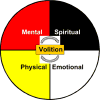Circle of life: rationale, design, and baseline results of an HIV prevention intervention among young American Indian adolescents of the Northern Plains
- PMID: 19798577
- PMCID: PMC4436973
- DOI: 10.1007/s11121-009-0153-x
Circle of life: rationale, design, and baseline results of an HIV prevention intervention among young American Indian adolescents of the Northern Plains
Abstract
In spite of significant disparities in sexual health outcomes for American Indian youth, no studies exist examining the effectiveness of HIV-prevention interventions. Circle of Life is an HIV-prevention intervention specifically developed for American Indian middle-school youth. We describe the rationale, methodology, and baseline results of a longitudinal randomized trial of Circle of Life conducted among American Indian youth aged 11-15 in a reservation community. The innovative design includes two pre-intervention waves to determine patterns of behavior prior to the intervention that might be associated with a differential impact of the intervention on sexual risk. We used one-way analysis of variance and chi-square tests to test for significant differences between randomized group assignment at each baseline wave and generalized estimating equations (GEE) to test significant differences in the rate of change in outcomes by group longitudinally. We present the collaborative and adaptive strategies for consenting, assenting, and data collection methodology in this community. Achieved response rates are comparable to other similar studies. Results from the two baseline waves indicate that few outcomes significantly varied by randomized intervention assignment. Ten percent of youth reported having had sex at Wave 1, rising to 15% at Wave 2. Among those who had had sex, the majority (>70%) reported using a condom at last sex. The project is well positioned to carry out the longitudinal assessments of the intervention to determine the overall impact of the Circle of Life and the differential impact by pre-intervention patterns of behavior across youth.
Figures
Similar articles
-
Effects of the "Circle of Life" HIV-prevention program on marijuana use among American Indian middle school youths: a group randomized trial in a Northern Plains tribe.Am J Drug Alcohol Abuse. 2018;44(1):120-128. doi: 10.1080/00952990.2016.1265122. Epub 2016 Dec 29. Am J Drug Alcohol Abuse. 2018. PMID: 28032813 Free PMC article. Clinical Trial.
-
Effectiveness of Circle of Life, an HIV-preventive intervention for American Indian middle school youths: a group randomized trial in a Northern Plains tribe.Am J Public Health. 2014 Jun;104(6):e106-12. doi: 10.2105/AJPH.2013.301822. Epub 2014 Apr 22. Am J Public Health. 2014. PMID: 24754555 Free PMC article. Clinical Trial.
-
Rigorous evaluation of a pregnancy prevention program for American Indian youth and adolescents: study protocol for a randomized controlled trial.Trials. 2017 Feb 27;18(1):89. doi: 10.1186/s13063-017-1842-6. Trials. 2017. PMID: 28241775 Free PMC article. Clinical Trial.
-
Rationale, Design, and Methods for Nen Unkumbi/Edahiyedo ("We Are Here Now"): A Multi-Level Randomized Controlled Trial to Improve Sexual and Reproductive Health Outcomes in a Northern Plains American Indian Reservation Community.Front Public Health. 2022 Jul 13;10:823228. doi: 10.3389/fpubh.2022.823228. eCollection 2022. Front Public Health. 2022. PMID: 35910931 Free PMC article. Clinical Trial.
-
Testing the efficacy of a brief sexual risk reduction intervention among high-risk American Indian adults: study protocol for a randomized controlled trial.BMC Public Health. 2016 Apr 29;16:366. doi: 10.1186/s12889-016-3040-y. BMC Public Health. 2016. PMID: 27129956 Free PMC article. Clinical Trial.
Cited by
-
Culturally Grounded Prevention for Minority Youth Populations: A Systematic Review of the Literature.J Prim Prev. 2016 Feb;37(1):11-32. doi: 10.1007/s10935-015-0414-3. J Prim Prev. 2016. PMID: 26733384 Free PMC article.
-
Effects of the "Circle of Life" HIV-prevention program on marijuana use among American Indian middle school youths: a group randomized trial in a Northern Plains tribe.Am J Drug Alcohol Abuse. 2018;44(1):120-128. doi: 10.1080/00952990.2016.1265122. Epub 2016 Dec 29. Am J Drug Alcohol Abuse. 2018. PMID: 28032813 Free PMC article. Clinical Trial.
-
Effectiveness of Circle of Life, an HIV-preventive intervention for American Indian middle school youths: a group randomized trial in a Northern Plains tribe.Am J Public Health. 2014 Jun;104(6):e106-12. doi: 10.2105/AJPH.2013.301822. Epub 2014 Apr 22. Am J Public Health. 2014. PMID: 24754555 Free PMC article. Clinical Trial.
-
Moving the prevention timeline: A scoping review of the literature on precursors to sexual risk in early adolescence among youth of color.J Adolesc. 2020 Apr;80:145-156. doi: 10.1016/j.adolescence.2020.02.012. Epub 2020 Feb 29. J Adolesc. 2020. PMID: 32126397 Free PMC article.
-
Baseline results from NenŨnkUmbi/EdaHiYedo: A randomized clinical trial to improve sexual and reproductive health among American Indian adolescents.J Adolesc. 2023 Jun;95(4):844-859. doi: 10.1002/jad.12158. Epub 2023 Mar 8. J Adolesc. 2023. PMID: 36890753 Free PMC article. Clinical Trial.
References
-
- South Dakota Department of Health. South Dakota HIV/AIDS Surveillance Report, January 2008. 2008 Retrieved March 31 2008, from http://doh.SD.gov/Disease/Documents/January08.pdf.
-
- Albarracin D, McNatt PS, Williams WR, Hoxworth T, Zenilman J, Ho RM, et al. Structure of outcome beliefs in condom use. Health Psychology. 2000;19:458–468. - PubMed
-
- Baele J, Dusseldorp E, Maes S. Condom use self-efficacy: Effect on intended and actual condom use in adolescents. Journal of Adolescent Health. 2001;28:421–431. - PubMed
-
- Bandura A. Self-efficacy: The exercise of control. New York: W.H. Freeman and Company; 1997.
-
- Bandura A, Caprara GV, Barbaranelli C, Gerbina M, Pastorelli C. Role of affective self-regulatory efficacy in diverse spheres of psychosocial funtioning. Child Development. 2003;74:769–782. - PubMed
Publication types
MeSH terms
Grants and funding
LinkOut - more resources
Full Text Sources
Medical



